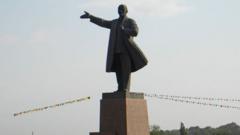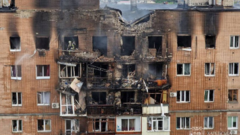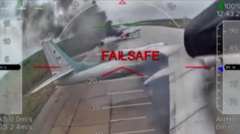Russia is reportedly expanding its military infrastructure near Finland's border, as evidenced by satellite images showing new tents, warehouses, and renovations to existing military facilities. NATO officials note this activity may not pose an immediate threat but reflects Russia's strategic adjustments against perceived challenges from NATO.
Russia Fortifies Military Presence Near Finland

Russia Fortifies Military Presence Near Finland
Recent satellite imagery reveals significant military enhancements by Russia along its border with Finland, signaling a potential shift in geopolitical strategies.
Russia's military posture along the Finnish border has come under scrutiny recently due to a marked increase in infrastructure activity captured through satellite imagery. These developments, confirmed by officials within NATO, indicate the establishment of new accommodations, including rows of tents designed to house troops, additional warehouses for military vehicles, and updates to shelters originally meant for fighter jets. Notably, there is construction underway at a previously dormant helicopter base.
Experts suggest this represents not merely a temporary enhancement but rather the groundwork for an extended military presence. The situation contrasts sharply with prior troop mobilizations seen on the Ukrainian border before Russia’s aggressive maneuvers in 2022. At this juncture, Russian troop counts along the Finnish frontier remain low, and Finnish authorities have downplayed the potential threats posed by these developments.
Finland’s recent accession to NATO, which occurred two years prior, positions it strategically at this 830-mile shared border—the longest contact line between NATO and Russia. Military analysts perceive this border as increasingly vital, especially considering the competing interests in the Arctic region.
Highlighting the changing dynamics, American and Finnish forces recently conducted a large-scale Arctic military exercise, engaging in tactical operations that implicitly framed Russia as the hypothetical adversary. This military drill, which showcased hundreds of troops navigating through forest terrains, underscores the readiness of NATO allies to address potential threats emerging from the east.
While the current military buildup may not indicate an imminent confrontation, it undeniably reflects Russia's evolving strategic calculus amidst its ongoing conflict in Ukraine and its broader implications for regional security in Northern Europe.
Experts suggest this represents not merely a temporary enhancement but rather the groundwork for an extended military presence. The situation contrasts sharply with prior troop mobilizations seen on the Ukrainian border before Russia’s aggressive maneuvers in 2022. At this juncture, Russian troop counts along the Finnish frontier remain low, and Finnish authorities have downplayed the potential threats posed by these developments.
Finland’s recent accession to NATO, which occurred two years prior, positions it strategically at this 830-mile shared border—the longest contact line between NATO and Russia. Military analysts perceive this border as increasingly vital, especially considering the competing interests in the Arctic region.
Highlighting the changing dynamics, American and Finnish forces recently conducted a large-scale Arctic military exercise, engaging in tactical operations that implicitly framed Russia as the hypothetical adversary. This military drill, which showcased hundreds of troops navigating through forest terrains, underscores the readiness of NATO allies to address potential threats emerging from the east.
While the current military buildup may not indicate an imminent confrontation, it undeniably reflects Russia's evolving strategic calculus amidst its ongoing conflict in Ukraine and its broader implications for regional security in Northern Europe.






















